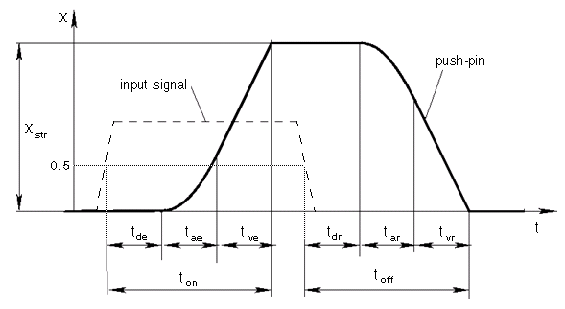3-Position Valve Actuator
(To be removed) Actuator for three-position valves
The Hydraulics (Isothermal) library will be removed in a future release. Use the Isothermal Liquid library instead.
For more information on updating your models, see Upgrading Hydraulic Models to Use Isothermal Liquid Blocks.
Library
Valve Actuators
Description
The 3-Position Valve Actuator block represents an actuator that you can use with directional valves to control their position. This actuator can drive a three-position valve. The block is developed as a data-sheet-based model and all its parameters are generally provided in catalogs or data sheets. The key parameters are the stroke, switch-on, and switch-off times.
The block has two signal inputs associated with the activation signals for electromagnets A or B. It produces a physical output signal that can be associated with a mechanical translational or rotational push-pin motion. Connect the block output to the directional valve control port.
The actuator is represented as an ideal transducer, where output does not depend on
the load exerted on the push-pin and the push-pin motion profile remains the same under
any loading conditions. The motion profile represents a typical transition curve for
electromagnetic actuators. The following figure shows the motion profile for a case when
the input signal is applied long enough for the push-pin to reach the end of the stroke
(xstr), and then the input
signal is removed, causing the push-pin to return to initial position:

The push-pin is actuated when the input signal value crosses the threshold of 50% of
the nominal input signal, where Nominal signal value is a block
parameter. The motion is divided into three phases, equal in time: delay
(tde), motion at constant
acceleration (tae), and motion at
constant velocity (tve). The motion
stops when the switch-on time (ton)
elapses. At this moment, the push-pin reaches the specified stroke value
(xstr). To return the push-pin
into initial position, the control signal must be removed, which causes the push-pin to
retract. The retract motion also consists of three phases, equal in time: delay
(tdr), motion at constant
acceleration (tar), and motion at
constant velocity (tvr). It follows
exactly the same profile but “stretches” over the switch-off time.
Switching-on time and Switching-off time
are the block parameters.
The signal applied to port A causes the output to move in positive direction. To shift the push-pin in negative direction, you must apply the signal to port B. Only one control signal can be applied at a time. This means that if the actuator is being controlled by the signal at port A, the push-pin must be allowed to return to initial position before the control signal at port B can be processed. The transition in any direction can be interrupted at any time by changing the input signal. If motion is interrupted, the switch-on or switch-off times are proportionally decreased depending on the instantaneous push-pin position.
Only positive signals activate the actuator. In other words, negative signals at ports A and B have no effect on the actuator, which is similar to the behavior of electromagnetically controlled 3-position directional valves.
Basic Assumptions and Limitations
Push-pin loading, such as inertia, spring, hydraulic forces, and so on, is not taken into account.
Parameters
- Push-pin stroke
The push-pin stroke. The default value is
0.01m.- Switching-on time
Time necessary to fully extend the push-pin after the control signal is applied. The default value is
0.1s.- Switching-off time
Time necessary to retract push-pin from fully extended position after the input signal is removed. The default value is
0.1s.- Nominal signal value
Sets the value of the nominal input signal. The output motion is initiated as the input signal crosses 50% value of the nominal signal. Other than that, the input signal has no effect on the motion profile. This parameter is meant to reproduce the rated voltage feature of an electromagnet. The default value is
24.- Initial position
Specifies the initial position of the push-pin. The parameter can have one of three values:
Extended positive,Extended negative, orNeutral. The default value isNeutral.In selecting the initial position, consider the following:
The steady-state push-pin position always corresponds to the control signal. In other words, zero signal keeps the push-pin at
Neutral, positive signal — atExtended positive, and negative signal — atExtended negative.At the start of simulation, if there is a discrepancy between the initial position of the push-pin, as specified by the Initial position parameter, and the control signal, the push-pin immediately starts moving towards the steady-state position designated by the control signal.
Ports
The block has the following ports:
APhysical signal input port associated with the port A input signal.
BPhysical signal input port associated with the port B input signal.
The block also has one physical signal output port, which is associated with the output signal (push-pin displacement).

